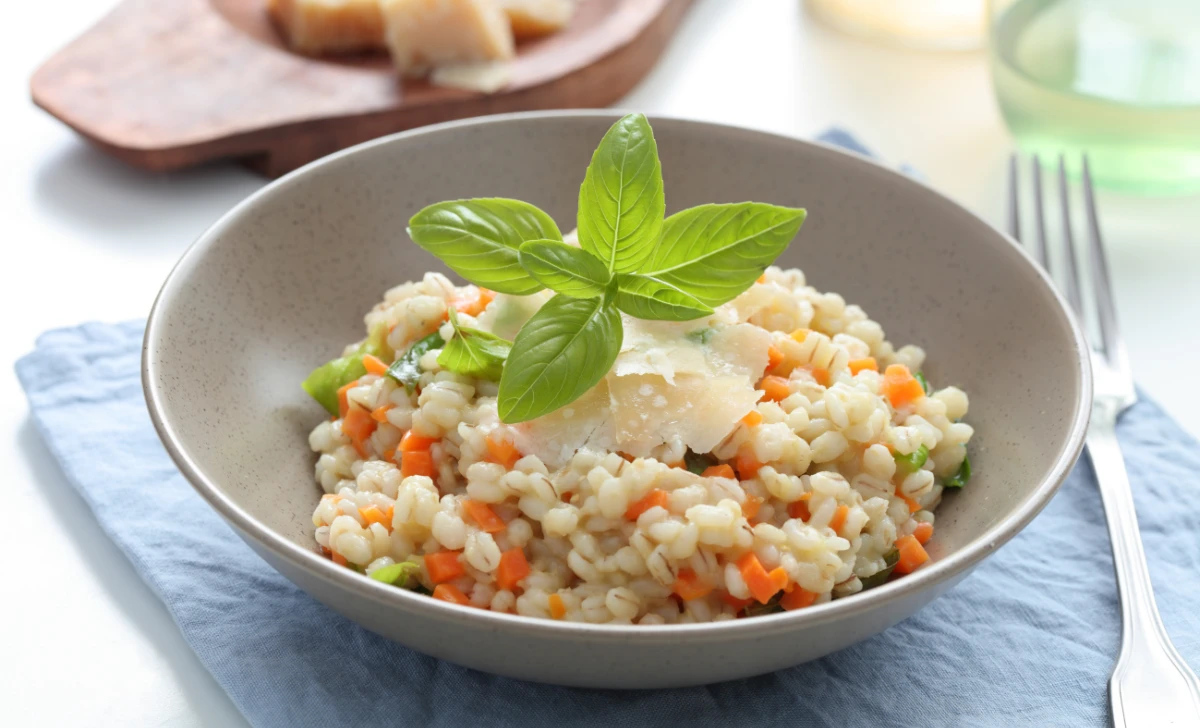Risotto is like a warm hug on a chilly evening, comforting and satisfying. But have you ever thought about giving this classic dish a wholesome twist? That’s where pearl barley comes in. This underrated grain adds a nutty flavor and a delightful chewiness to your risotto, taking it to a whole new level of deliciousness. In this article, we’ll walk you through the steps of creating a delectable pearl barley risotto that will leave your taste buds dancing. So, grab your apron and let’s dive into the world of flavorful innovation!
[ez-toc]
History
Risotto, the Italian comfort dish that warms hearts and brings families together, has a rich history that dates back centuries. But the evolution of this beloved dish didn’t stop with Arborio rice. Instead, it took a delicious detour with the introduction of pearl barley. Let’s journey through time and trace the footsteps of pearl barley risotto as it made its mark on culinary history.
Ancient Roots: A Glimpse into Early Risotto
The roots of risotto trace back to the rich farmlands of Northern Italy, where rice became a staple due to the region’s wet conditions. This simple dish began as rice cooked in broth until creamy, nourishing peasants and nobles alike. The slow-cooking method and the addition of various ingredients led to endless variations, each reflecting the culinary preferences of the local culture.
Rice Takes Center Stage
As risotto gained popularity, Arborio rice emerged as the preferred grain due to its high starch content. This characteristic allowed Arborio rice to absorb flavors and release starches, creating the creamy consistency that defines risotto. From saffron-infused Milanese risotto to seafood-rich Venetian risotto, Arborio rice became the canvas for gastronomic artistry.
The Wholesome Twist: Pearl Barley Enters the Scene
Amidst the traditional reverence for Arborio rice, a culinary maverick dared to experiment with risotto’s core ingredient. Pearl barley, often overlooked in modern times, played a significant role in ancient diets due to its durability and nutritional value. Its nutty flavor and chewy texture were an ideal match for the creamy world of risotto.
A New Chapter Unfolds
The early 21st century witnessed a resurgence of interest in ancient grains and whole foods. Chefs and home cooks alike began to explore beyond the familiar, seeking healthier and more diverse alternatives. It was during this wave of culinary exploration that pearl barley found its way back into the spotlight.
The Birth of Pearl Barley Risotto
The fusion of tradition and innovation led to the birth of pearl barley risotto. This dish was a celebration of the past and a nod to the future. By substituting Arborio rice with pearl barley, chefs and food enthusiasts unlocked a new realm of flavors and textures. The chewiness of pearl barley offered a delightful contrast to the creamy backdrop, creating a symphony of sensations with every bite.
A Journey Through Flavor and Time
Pearl barley risotto quickly became a canvas for creativity. Cooks experimented with various vegetable and protein combinations, exploring the balance between the barley’s nuttiness and the dish’s overall richness. From wild mushroom medleys to tangy citrus accents, the possibilities seemed endless.
Culinary Reimagination
Pearl barley risotto wasn’t just about flavor; it symbolized a larger culinary shift. It signified a return to whole, unprocessed foods and a reconnection with ancient grains. It was a statement that innovation need not forsake tradition, and health need not compromise taste.
Today and Beyond: Pearl Barley Risotto’s Legacy
As we stand in the present day, pearl barley risotto continues to enchant palates and challenge preconceptions. It speaks to a culinary philosophy that embraces diversity and nourishment, celebrating the art of transformation in the kitchen. Whether enjoyed in the comfort of home or savored in a gourmet restaurant, pearl barley risotto tells a story of evolution, flavor, and the enduring magic of food.
Time
| Step | Time |
|---|---|
| Preparing the Base | 10 minutes |
| Toasting the Pearl Barley | 5 minutes |
| Bringing in the Broth | 20 minutes |
| Adding the Goodness – Veggies and More | 15 minutes |
| Creaminess is Key | 10 minutes |
| Mushroom Medley Delight | 10 minutes |
| Zesty Lemon and Asparagus Twist | 10 minutes |
| Sundried Tomato and Spinach Infusion | 10 minutes |
| Total Cooking Time | 1 hour 30 minutes |
Please note that these times are approximate and may vary based on your cooking experience and equipment. Enjoy your culinary adventure!
Ingredients
| Ingredients | Quantity |
|---|---|
| Pearl barley | 1/2 cup |
| Vegetable or chicken broth | 3 cups |
| Onion | 1 small |
| Garlic cloves | 2 |
| Assorted vegetables | 1 cup |
| Parmesan cheese | 1/2 cup |
| White wine | 1/4 cup |
| Fresh herbs | A handful |
| Salt and pepper | To taste |
Adjust the quantities based on your preferences and enjoy your delicious homemade meal!
Directions
Step 1: Preparing the Base
- Sauté the Aromatics: In a medium-sized pan, heat a drizzle of olive oil over medium heat. Add finely chopped onions and minced garlic. Sauté until the onions turn translucent, releasing their aromatic fragrance.
Step 2: Toasting the Pearl Barley
- Introduce the Barley: Toss in the pearl barley and let it mingle with the sautéed aromatics. Stir occasionally for about 5 minutes, allowing the barley to toast and develop a nutty flavor.
Step 3: Bringing in the Broth
- Add Broth Gradually: Warm up the vegetable or chicken broth in a separate pot. Begin adding the warm broth to the pan with the barley, one ladle at a time. Stir gently as the barley absorbs the liquid.
Step 4: Adding the Goodness – Veggies and More
- Incorporate Vegetables: As the barley cooks and absorbs the broth, introduce your choice of assorted vegetables. Whether it’s vibrant bell peppers, tender asparagus, or any other favorites, add them to the pan and let the flavors meld.
Step 5: Creaminess is Key
- Fold in the Cheese: Stir in the grated Parmesan cheese, allowing it to melt and create a luscious, creamy texture. The cheese adds depth and richness to your risotto.
Step 6: Flavorful Variations to Explore
- Experiment with Flavors: If you’re feeling adventurous, this is the time to explore flavorful variations. Consider adding a mushroom medley, a zesty lemon and asparagus twist, or a sundried tomato and spinach infusion for an exciting burst of taste.
Step 7: Seasoning and Serving
- Season to Perfection: Taste your risotto and season with salt and pepper to your liking. Remember, a little goes a long way, so start conservatively and adjust as needed.
- Garnish and Serve: Once your risotto reaches the desired creamy consistency, turn off the heat. Garnish with a sprinkle of fresh herbs, such as chopped parsley or thyme. Serve your pearl barley risotto warm and enjoy!
Step 8: Cooking with Love
- Infuse with Heart: Remember, cooking isn’t just about following steps; it’s about infusing your dish with love and creativity. Your personal touch and passion will shine through in every delectable bite.
Step 9: Embrace Leftovers
- Transform Day-Old Risotto: Don’t let leftovers go to waste. Embrace the magic of reinventing day-old risotto by transforming it into arancini, risotto cakes, or even a hearty soup.
Step 10: Presentation Matters
- Serve with Style: Remember that presentation matters. Serve your pearl barley risotto in a visually appealing manner, perhaps with an artistic drizzle of olive oil or an extra sprinkle of herbs.
Equipment Required
Nutrition Information
| Nutrient | Amount per Serving |
|---|---|
| Serving Size | 1 cup |
| Calories | 300 |
| Total Fat | 8g |
| – Saturated Fat | 4g |
| Cholesterol | 15mg |
| Sodium | 600mg |
| Total Carbohydrates | 45g |
| – Dietary Fiber | 6g |
| – Sugars | 4g |
| Protein | 12g |
Please note that these values are approximate and can vary based on specific ingredients and portion sizes. Enjoy your delicious and nutritious pearl barley risotto!
Tips
- Stay Stir Crazy: Regular stirring is key to achieving that creamy consistency. It encourages the barley to release its starches, resulting in a velvety texture.
- Warm Broth: Keep your broth warm on a nearby burner as you add it gradually. This maintains a consistent temperature and ensures smooth absorption.
- Patience Pays Off: Risotto is a labor of love that rewards patience. Allow the flavors to develop with each addition of broth and ingredient.
- The Right Arborio Substitution: Can’t find pearl barley? Arborio rice can still make a fantastic risotto, so don’t hesitate to substitute if needed.
- Mind the Wine: If you’re skipping wine, replace it with extra broth. However, the wine adds depth and flavor, so consider keeping it for the best taste.
Pros & Cons
| Pros | Cons |
|---|---|
| ✔️ Nutrient-rich whole grain | ❌ Requires attentive stirring |
| ✔️ Lower glycemic index | ❌ Longer cooking time compared to some dishes |
| ✔️ High fiber content | ❌ Some may find pearl barley unfamiliar |
| ✔️ Versatile with flavor pairings | ❌ Not suitable for those with barley allergies |
| ✔️ Creamy and satisfying | ❌ Potential for overcooked or undercooked barley |
Conclusion
In the realm of culinary adventures, few dishes capture the essence of comfort and creativity quite like pearl barley risotto. This recipe brings together the rich history of traditional risotto and the wholesome charm of pearl barley, resulting in a symphony of flavors and textures that dance on your palate.
From the moment you sauté the aromatics to the final sprinkle of fresh herbs, each step is an invitation to infuse your creation with your unique touch. The nutty allure of pearl barley, the creamy embrace of cheese, and the vibrant medley of vegetables harmonize into a dish that’s not just a meal but a masterpiece.
Whether you’re a seasoned cook seeking new horizons or a curious novice looking to embark on a culinary journey, pearl barley risotto welcomes all with open arms. It’s a canvas for your creativity, a celebration of nutrition, and an homage to the art of slow cooking.
So, don your apron, gather your ingredients, and let the kitchen become your stage. Embrace the simmering, the stirring, and the savoring. With every bite, you’ll taste the history, the innovation, and the love you’ve poured into your creation. Pearl barley risotto is more than a recipe; it’s an experience waiting to be savored. Don’t resist the urge—grab your culinary scepter and dive into the world of delectable delight. Your taste buds are in for an enchanting treat!
Facts
- Fact 1: 🌾 Ancient Roots and Renaissance Resurgence
- Did you know that risotto dates back to ancient Rome? It was called “puls” and made with spelt, an ancestor of barley. Fast forward to the Renaissance, and rice took the stage, transforming into the creamy delight we know today as risotto!
- Fact 2: 🎭 The Drama of Stirring
- Stirring risotto isn’t just cooking; it’s a performance! The slow, rhythmic stirring releases the grains’ starches, creating that signature creamy texture. Consider yourself the star of your own kitchen drama!
- Fact 3: 🧀 Parmesan – The Risotto Superstar
- Parmesan cheese isn’t just an ingredient; it’s the rock star of risotto. Italians call it “il formaggio padano,” and it’s not just a cheese – it’s a cultural icon that transforms dishes with its rich umami magic.
- Fact 4: 🌍 Pearl Barley’s Global Journey
- Pearl barley’s journey spans the globe. Ancient Egyptians used it for brewing beer, Greeks for making bread, and Romans as a staple. Fast forward to today, and it’s the star of your risotto, adding nutty flavor and a chewy bite!
- Fact 5: 🌱 Innovate, Elevate, and Surprise!
- The pearl barley risotto recipe isn’t just about cooking; it’s about innovation. From adding exotic mushrooms to zesty citrus twists, risotto’s canvas is limitless. So, go ahead, surprise your taste buds, and paint your palate with delight!
FAQ’s
Can I use regular barley instead of pearl barley?
While pearl barley is recommended for its tender texture, you can use regular barley with some adjustments. Regular barley might require a longer cooking time and more liquid to achieve the desired creaminess.
Can I make pearl barley risotto in advance?
Yes, you can make pearl barley risotto in advance. However, it’s best to slightly undercook the barley before refrigerating. Reheat gently with a splash of broth or water to regain the creamy consistency.
What other cheeses can I use besides Parmesan?
You can experiment with various cheeses like Asiago, Pecorino Romano, or even blue cheese for unique flavor profiles. Adjust quantities to taste.
Can I freeze pearl barley risotto?
While possible, freezing risotto can affect its texture. If you choose to freeze, slightly undercook the barley and omit the cheese. Thaw in the refrigerator and gently reheat with additional broth.
How can I prevent overcooking the pearl barley?
To prevent overcooking, monitor the barley’s texture as you add broth. It should be tender with a slight chew. Taste test and adjust cooking time as needed.
What’s the difference between pearl barley and Arborio rice?
Pearl barley is a whole grain with nutty flavor and chewy texture, while Arborio rice is a starchy rice variety used for creamy dishes like risotto. The choice depends on your preference for taste and texture.
Can I make a vegan version of pearl barley risotto?
Absolutely! Replace Parmesan cheese with nutritional yeast, and use vegetable broth. You can also add plant-based protein sources like tofu or legumes.
Is pearl barley risotto gluten-free?
While pearl barley contains gluten, you can make a gluten-free version using gluten-free grains like Arborio rice or quinoa.
Can I add meat to the recipe?
Certainly! Cooked chicken, shrimp, or even bacon can be added for extra protein and flavor. Add them during the vegetable cooking step.
How can I achieve a creamy texture without dairy?
For a dairy-free creamy texture, use coconut milk or cashew cream instead of cheese. Nutritional yeast can also add a cheesy flavor.












Leave a Review